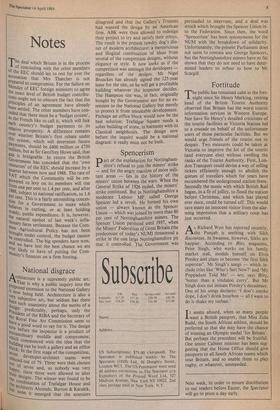National disgrace
Architecture is a supremely public art. That is why a public inquiry into the Proposed extension to the National Gallery now being held. Architecture is also a
yberY subjective art, but seldom has there
PsPen sign: unanimity about the merits of a l8n: predictably, perhaps, only the the Royal of the RIBA and the Secretary of t
Royal Fine Art Commission seem to Royal Fine Art Commission seem to
have a good word to say for it. The design now before the inspector is a product of extraordinary muddle and compromise, which commenced with the idea that the br'dtri8 can be both a gallery and an office s °ck. In the first stage of the competition, selected out teams were !elected out of 79. Three were then chosen l'ult of seven and, as nobody was very thPPY, these three were allowed to alter e'r designs. The winner was found to be tLe combih nation of Trafalgar House and butte arcitects Ahrends, Burton & Karalek, soon
emerged that the assessors
disagreed and that the Gallery's Trustees had wanted the design by an American firm. ABK were then allowed to redesign their project to try and satisfy their critics. The result is the present tawdry dog's din- ner of modern architecture: a meretricious and illogical combination of ideas from several of the competition designs, without elegance or style. It now looks as if the competition was amongst the developers regardless of the designs. Mr Nigel Broackes has already signed the 125-year lease for the site, so he will get a profitable building whatever the inspector decides. The Hampton site was, in fact, originally bought by the Government not for an ex- tension to the National Gallery but merely to protect it from unsuitable development. Perhaps an office block would now be the best solution: Trafalgar Square needs a sober building of stone, in harmony with its Classical neighbours. The design now before the inquiry would be a national disgrace: it really must not be built.










































 Previous page
Previous page